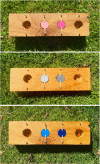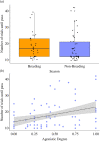Aggressive interactions influence cognitive performance in Western Australian magpies
- PMID: 38835280
- PMCID: PMC11285866
- DOI: 10.1098/rspb.2024.0435
Aggressive interactions influence cognitive performance in Western Australian magpies
Abstract
Extensive research has investigated the relationship between the social environment and cognition, suggesting that social complexity may drive cognitive evolution and development. However, evidence for this relationship remains equivocal. Group size is often used as a measure of social complexity, but this may not capture intraspecific variation in social interactions. Social network analysis can provide insight into the cognitively demanding challenges associated with group living at the individual level. Here, we use social networks to investigate whether the cognitive performance of wild Western Australian magpies (Gymnorhina tibicen dorsalis) is related to group size and individual social connectedness. We quantified social connectedness using four interaction types: proximity, affiliative, agonistic and vocal. Consistent with previous research on this species, individuals in larger groups performed better on an associative learning task. However, social network position was also related to cognitive performance. Individuals receiving aggressive interactions performed better, while those involved in aggressive interactions with more group members performed worse. Overall, this suggests that cognitive performance is related to specific types of social interaction. The findings from this study highlight the value of considering fine-grained metrics of sociality that capture the challenges associated with social life when testing the relationship between the social environment and cognition.
Keywords: aggression; cognition; repeatability; social complexity; social intelligence; social network.
Conflict of interest statement
We declare we have no competing interests.
Figures




Similar articles
-
Heritability of cognitive performance in wild Western Australian magpies.R Soc Open Sci. 2024 Mar 13;11(3):231399. doi: 10.1098/rsos.231399. eCollection 2024 Mar. R Soc Open Sci. 2024. PMID: 38481983 Free PMC article.
-
Call combination production is linked to the social environment in Western Australian magpies (Gymnorhina tibicen dorsalis).Philos Trans R Soc Lond B Biol Sci. 2024 Jul 8;379(1905):20230198. doi: 10.1098/rstb.2023.0198. Epub 2024 May 20. Philos Trans R Soc Lond B Biol Sci. 2024. PMID: 38768205 Free PMC article.
-
Group size affects spontaneous quantity discrimination performance in wild Western Australian magpies (Gymnorhina tibicen dorsalis).Anim Cogn. 2025 May 26;28(1):41. doi: 10.1007/s10071-025-01963-0. Anim Cogn. 2025. PMID: 40418245 Free PMC article.
-
An intraspecific appraisal of the social intelligence hypothesis.Philos Trans R Soc Lond B Biol Sci. 2018 Sep 26;373(1756):20170288. doi: 10.1098/rstb.2017.0288. Philos Trans R Soc Lond B Biol Sci. 2018. PMID: 30104433 Free PMC article. Review.
-
How does cognition shape social relationships?Philos Trans R Soc Lond B Biol Sci. 2018 Sep 26;373(1756):20170293. doi: 10.1098/rstb.2017.0293. Philos Trans R Soc Lond B Biol Sci. 2018. PMID: 30104437 Free PMC article. Review.
References
-
- Shettleworth SJ. 2001. Animal cognition and animal behaviour. Anim. Behav. 61 , 277–286. (10.1006/anbe.2000.1606) - DOI
-
- Chance M, Mead A. 1953. Social behaviour and primate evolution. Symp. Soc. Exp. Biol. 7 , 395–439.
-
- Humphrey NK. 1976. The social function of intellect. In Growing points in ethology (eds Bateson PPG, Hinde RA), pp. 303–317. Cambridge, UK: Cambridge University Press.
MeSH terms
LinkOut - more resources
Full Text Sources

